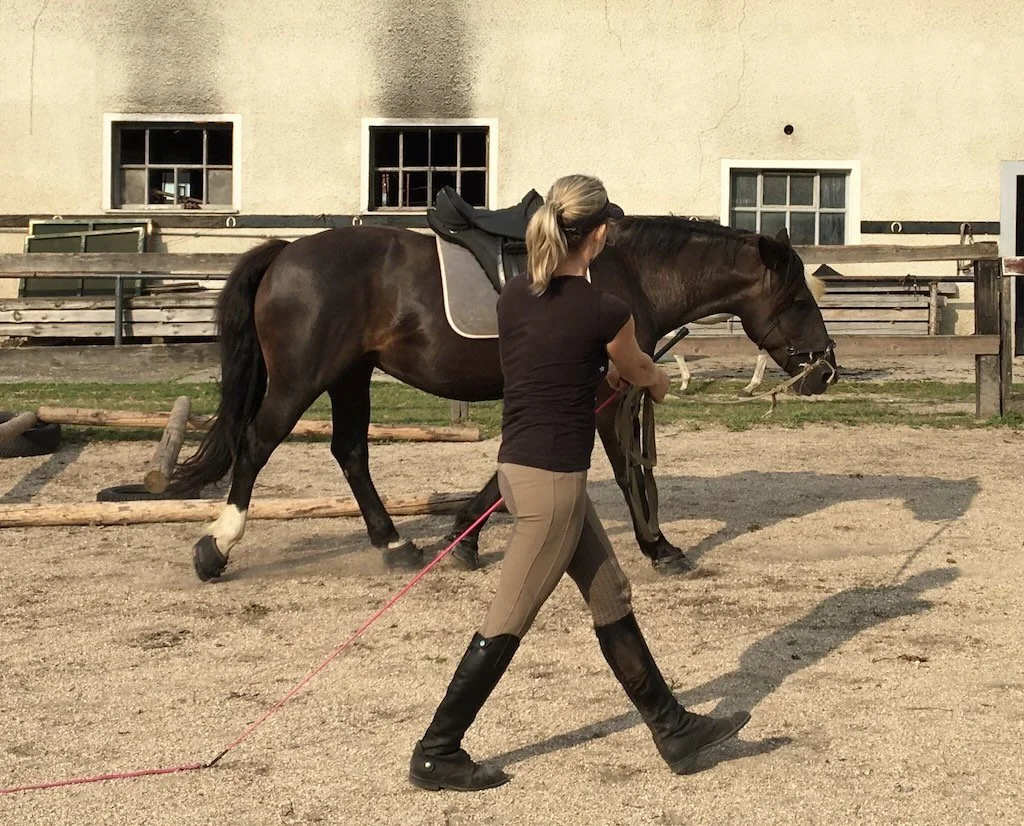Solving riddles
Here are some tips on how to approach a horse that is not lame, but randomly feels “off”.
Observing your horse in different circumstances will give you a lot of information. Make sure to write down any observations, as they might give you clues where to look next.
Very often, riders will say that their horse isn’t lame, but he just feels a bit “off”. This can be a tricky thing to investigate, because the “off-ness” sometimes only shows up in seemingly random situations. When we are dealing with a very loosely defined problem, we have to put on our detective hat and look for potential clues. It helps to be systematic about it. We can start by putting the horse through various movements and noting when the “off-ness” shows up. Here are some ideas to get started with the puzzle.
Hard vs. soft ground
The hardness of the footing affects various structures of the body. For example, on soft ground, soft tissues like muscles and tendons need to stretch more and work harder because the body sinks into the ground more. Imagine walking in deep sand—you will feel your muscles work way more after an hour of walking on sand than after an hour on pavement. On the other hand, on hard ground that doesn’t dampen any locomotive forces, it will be the joints that will take most of the impact. So, if the problem seems worse on soft ground, the issue is more likely to be soft tissue than joint. On the other hand, problems that only arise on hard ground are more likely to be joint-related.
Straight line vs. circle
The horse’s body is made to move in straight lines. That’s what they were built for. Circles are tough on horses, and they have a particular impact on their bodies. Most often, any problem will become more obvious on a circle, but because compensation patterns can get very complex in circular motion, it makes sense to pay more attention to how the horse is walking on a straight line. Observe for any deviation from moving on two tracks, observe for (a)symmetry in the movement of the pelvis, the ribcage and the protraction or retraction of all four feet. Observe the horse from the front, behind and from the side and make notes of anything that catches your eye. Armed with this information, try the circle. In this way, what you see in circular motion might make more sense.
Left vs. right circle
Usually, when there is a problem, the horse will be worse when going on a circle on one side compared to the other. It’s essential to keep in mind that because the horse is bent on a circle, his left and right limbs will be working differently. For example, the inner leg will have to bear more weight, while the outer leg will have to make a bigger step. The general rule of thumb is that if the horse is worse when the affected leg is on the inside, there is a problem with weight bearing. Conversely, if the problem is worse when the affected leg is on the outside, the problem is more likely to be a range-of-motion problem. Since it’s the lower leg that is more involved with weight bearing and the upper leg is more involved with range of motion, very often it will be a lower leg problem, if it’s worse, when the affected leg is on the inside and a problem higher up if it’s worse when the affected leg is on the outside. For example, a horse that doesn’t feel right in his right hind leg is worse on a right circle - more likely a lower limb issue. If the problem is worse going to the left - more likely a problem higher up.
Tacked up vs. no tack
This one is pretty simple if you think about it. If the horse is worse with the tack on, there might be a problem with the tack itself. If the horse is only stiff when he has a saddle on, there’s a good chance it’s the saddle that’s causing the issue. It can also be the case that the fit is ok, but there’s a problem with one of the structures the tack is in contact with. For example, if the horse injured his pectoral muscle, the pressure of the girth might exacerbate the pain. If the withers are painful (due to something like an ill-fitting rug), the pressure from the saddle pad might cause the horse to hollow his back.
Of course, horses are masters at disguising what ails them, so this is a very general outline that won’t be true for every horse. Think of this process as general guidelines in recognizing where the problem is coming from, not as a rulebook. Using this template will give you more information to play with and more information will give you more options in terms of hypotheses. The next steps are up to you. If you suspect there’s a problem with a certain structure, ask yourself what that structure does. What circumstance would cause it to work harder? In which situation should it work less? This way of thinking can help you pinpoint less obvious problems. And knowing where the problem stems from gives you a much better chance of solving it.
